Lab News:

May 2020 – In a follow-up to the paper by Donihue et al. (2018) finding hurricane-induced selection favors larger toepads in anoles, a team of collaborators led by Colin Donihue (and including our lab) discovered the imprint of selection on anole toepads caused by hurricanes extends across populations on Bahamian islands and is detectable among species in the Anolis clade (click here). Using historical data on hurricanes, researchers found consistent positive relationships between toepad area and hurricane activity: more hurricanes means larger toepads for lizards. This translates into greater clinging ability in the face of strong winds. The strong, but short-lived, selection caused by hurricanes has a longer-lasting influence on phenotypic diversity than previously realized.

April 2020 – An abundance of educational resources about anoles exist online, nicely summarized on the Anole Annals website (click here). In particular, Nate Dappen and Neil Losin at Day’s Edge Productions produced a series of short films about a variety of ecological and evolutionary topics, and the best part, they all feature anoles! You can view all seven shorts on Youtube under the title The Lizard’s Tale. Episode 7 called Anoles in the City was a finalist at the Jackson Wild Media Awards. See if you can spot any familiar faces.

- March 2020 – Hurricane Dorian was a devastating Category 5 storm that slowly moved across Marsh Harbour in the Bahamas on September 5, 2019. The eye of the hurricane passed within kilometers of our study islands in Abaco. Jess and Jason traveled with colleagues to our field sites for a NSF-funded project to assess the behavior and morphology of brown anole populations that survived the hurricane. The damage seven months after the storm was still apparent on the main island and our hearts go out to the residents of Abaco. Evidence of the hurricane was also apparent on our study islands with dead trees, flipped rocks and seaweed high off the ground in the vegetation. Dr. Sean Giery is pictured next to an uprooted tree on one of our study islands. Stayed tuned for updates on our findings!

January 2020 - Our lab collaborated with Florida International University and Fairchild Tropical Botanic Garden to develop and support authentic, school-based ecological research on anoles in the Miami area. Since 2014, thousands of students have participated in our “Lizards on the Loose” challenge, collecting, analyzing and presenting data in Powerpoint, posters and videos. Students used iNaturalist, a web-based citizen science platform, to record anole locality information and upload photos (2018 and 2019 observations). URI undergrad Amy Kostka worked with postdoc Dr. Chris Thawley using these and other observations of anoles in Florida to collect data on behavior, ecology and habitat use. Chris presented this research at the 2020 Society for Comparative and Integrative Biology meeting in Austin.

- December 2019 - Ked Brown presented on his summer research project that he conducted in our lab as part of the Science and Engineering Fellows Program at URI. The Annual Undergraduate Fellows Celebration gives students, faculty and staff the opportunity to hear about the amazing diversity of research projects that students conducted in the summer and fall of 2019. Ked presented a poster entitled "Comparison of tail autotomy rates in Anolis lizards from urban and natural forest habitats." He worked with graduate student Jess Pita-Aquino and postdoc Chris Thawley to better understand the ways urban and natural forest habitats differ for lizards. Great job Ked!

December 2019 – Each semester I teach a seminar course for junior and senior Biology majors called Biology & Society (BIO 396). For the last several years I’ve focused on evolution, both how evolution shapes our lives and how humans cause evolution in other species. This allows us to explore a wide variety of themes from human origins, Darwin’s discoveries, vertebrate evolutionary history and contemporary evolution caused by recent, human-mediated global change. My favorite part of the course is the Integrative Project where I challenge students to create a visually effective project that demonstrates their understanding of the reciprocal relationship and influences of evolution and society and integrates and applies their knowledge of evolution and society to a specific audience. The creativity, innovation and thoughtfulness of these projects never ceases to amaze me! Students have created original artwork, board games, cartoon strips, children’s books, songs, stand-up comedy routines and video games, among many other projects.

- June 2019 – Check out this recent paper on the role of top predators in structuring food webs and regulating biodiversity (click here). In a massive experiment manipulating whole-island ecosystems on small Bahamian islands, Rob Pringle and a host of collaborators (including our lab) show that curly-tailed lizards destabilize the coexistence of competing brown and green anoles. Anoles avoid this voracious predator out of fear, which collapses the spatial and dietary niche structure and intensifies competition between the two anole species. These results contradict the classic idea that keystone predators enhance biodiversity and show that non-consumptive effects can influence species coexistence.

December 2018 – Collaborators and friends Nate Dappen and Neil Losin at Day's Edge Productions produced an hour-long documentary on anoles called Laws of the Lizard. They featured our research on Anolis lizards in the Bahamas and Miami. It was great fun to be interviewed and help with filming on location at our field sites. After wonderful events screening the film and answering questions from audiences at the Museum of Comparative Zoology at Harvard University and the Frost Museum of Science in Miami, the film premiered on December 26th on the Smithsonian Channel. The film won the Grand Helix Award at the 2018 Science Media Awards and was a finalist at the 2018 Jackson Wild Media Awards (the "Oscars" of wildlife films). Congrats Nate and Neil!

- July 2018 – The devastating effects of hurricanes on humans and ecological systems are well known. But whether hurricanes and other extreme weather events have the potential to influence the course of evolution is less understood. Comparing before and after hurricane samples of anoles on small islands in the Turks & Caicos, Colin Donihue and colleagues (including our lab) showed that selection favored lizards with larger toepads and longer forelimbs, which should increase the ability of lizards to cling onto vegetation during the high winds of a hurricane (video). It will be interesting to see whether this selection results in evolutionary change in subsequent generations. The picture shows an anole clinging to a wooden dowel under simulated hurricane-force winds generated by a leaf blower.

June 2018 - Two years ago we started an experiment to assess whether natural selection acts on variation in risk-taking behavior of brown anoles when they occupy small islands in the Bahamas with and without curly-tailed lizards, a major ground predator. This work was spearheaded by postdoc Dr. Oriol Lapiedra and the first paper from this experiment was published last week in the journal Science [PDF]. We found that exploratory behavior of brown anoles was favored in the absence of the predator, whereas avoidance of the ground was favored when they co-existed with the predator. Moreover, selection on behavior was stronger than selection on morphology when the predator was present. Here's a video describing the project and some nice media coverage of the paper. [Harvard] [Wash U] [UC Davis] [Forbes]

- May 2018 - As part of her NSF Graduate Research Fellowship, Ph.D. student Christina de Jesus Villanueva will be taking advantage of the Graduate Research Internship Program (GRIP) to do a one-year internship with the USDA's International Institute of Tropical Forestry in San Juan, Puerto Rico. Christina's research focuses on identifying factors associated with agricultural crop damage by invasive green iguanas in Puerto Rico and the effectiveness of management strategies employed by farmers. She is interested in combining surveys and interviews with ecological experiments and landscape modeling to predict the risks to agriculture in Puerto Rico due to invasive green iguanas. The research expertise at the Institute is a great fit for Christina's interests.
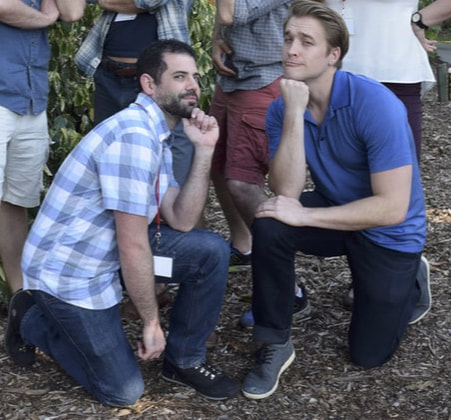
- April 2018 - Congratulations to Zac and Andrew, who successfully defended their Ph.D. dissertations this month! They both did their research on the effects of urbanization on Anolis lizard populations in south Florida. Zac's dissertation is entitled "Impacts of urbanization and invasive species on foraging behavior and body size in Anolis sageri." He has already published one chapter (see here) from his dissertation. Andrew's dissertation is "The effects of urbanization on performance, habitat selection, and persistence of Anolis lizards." He focused on two important anole niche axes: structural habitat and thermal microclimate. Keep an eye out for some great papers to come from their research. Apologies for recycling the photo, but it's such a good one.
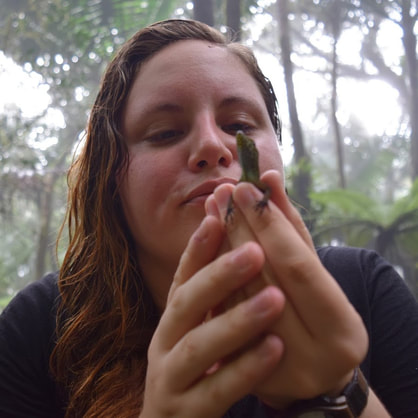
April 2018 - Congratulations to graduate student Jessica Pita Aquino for winning a prestigious National Science Foundation Graduate Research Fellowship. Jess is interested in how anole populations respond to global change, such as species invasions and climate change. This spring and summer she will be working with postdoc Dr. Dan Bock studying the brown anole invasion in Florida. Great job Jess!

- March 2018 - Most of the lab headed to sunny Miami during spring break to attend the Anolis Symposium VII. Sozos gave a talk about invasion genetics of anoles in Bermuda, Andrew talked about how anoles in Miami are handling the urban heat, Chris discussed the effects of artificial light at night on anoles, and Zac talked about how predators influence the body size of anoles in urban areas. All reports agree it was a great meeting held at the beautiful Fairchild Tropical Botanic Garden, our partner in the Lizards on the Loose citizen science project. From the looks of this photo our lab may have a future as a band, well at least they have their look down (L to R: Dan, Sozos, Chris, Jess; Front: Zac & Andrew).
December 2017 - Tia Mitchell and Noah Gilbert, our two Coastal Fellows for 2017, presented their summer projects at the Annual Undergraduate Fellows Celebration at URI. With over 70 poster presentations, it was a well-attended event that provided an opportunity for students, faculty, alumni and employers to connect. Tia presented “How do urbanization and invasive predators affect the morphology of a common lizard.” Here’s what she had to say about her experience: "I absolutely loved working on this project and was able to learn a lot about invasive species, urbanization, animal husbandry, and experimental design. I'm going to miss those little lizards!" Noah presented his poster “Evolutionary genetics of a lizard invasion: The case of the Anolis wattsi introduction to Trinidad”. Here’s what he had to say about his experience: “My favorite part about the entire project was getting to contribute something new to the web of knowledge, it's a cool feeling!" Great work Tia and Noah!

July 2017 - Chris presented his recent results on the effects of artificial light at night on reproduction in brown anoles (Anolis sageri) at the 2017 Joint Meeting of Ichthyologists and Herpetologists in Austin, TX. See a review of his talk at Anole Annals!
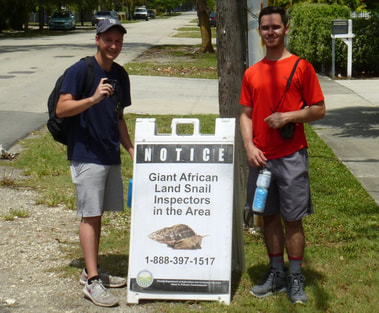
- May 2017 - In collaboration with Fairchild Tropical Botanic Garden's Fairchild Challenge program and Florida International University, we are studying the abundance and distribution of introduced Anolis species throughout Miami. Undergraduates Noah Gilbert (Coastal Fellow, U Rhode Island) and Marcos Vargas Rodriguez (Science & Engineering Fellow, U Puerto Rico Cayey) went to the field in Miami with postdoc Chris Thawley this summer to survey for the presence and absence of the Puerto Rican crested anole (Anolis cristatellus), which was introduced to Miami in the 1970s. Chris and James Stroud (FIU) put together a great video about the project. Luckily they didn't get into any scraps with Giant African Land Snails!

April 2017 - The stories of scientists completing their research projects are seldom told. In an effort to share the behind the science experience of her project, Christina has published Tales from the “Iguana Girl”: an anecdotal account of Puerto Ricans' interactions with and perceptions of invasive Green Iguanas (Iguana iguana) in the recent issue of IRCF Reptiles & Amphibians: Conservation and Natural History. Christina details her experience collecting samples for her Master’s thesis on the origin of invasive Green Iguanas in Puerto Rico. She collaborated with hunters, public agencies and urged many others to care about invasive species as a part of her work. Together with a string of photographs that document her experience, the publication is a peek into what scientists can learn while attempting to answer their scientific questions.
Download Tales from the “Iguana girl” here
Download Tales from the “Iguana girl” here

- April 2017 - Congratulations to current postdoc Dr. Chris Thawley, who was awarded a National Science Foundation Postdoctoral Research Fellowship in Biology. The fellowship will support Chris for two years as he investigates how artificial light at night (ALAN) affects anoles in urbanized areas. Chris will also be building opportunities in biology for students from underrepresented minorities, including through URI’s Science and Engineering Fellows program and by continuing our lab's collaboration with the Fairchild Challenge program to create educational opportunities for students in Miami area schools. Chris' project is co-advised by Dr. Bryan Dewsbury at URI.

March 2017 - Christina attended the Student Conference on Conservation Science hosted by the Department of Zoology at the University of Cambridge (UK). She presented her research on invasive green iguanas in Puerto Rico, attended workshops on survey design, and networked with other early-career conservationists from around the world. Check out her short piece about the conference here.

January 2017 - Hanna and Jason once again headed to Staniel Cay (Bahamas) to meet up with members of the Barrett and Pringle Labs for some fieldwork. This time the focus was on sampling green anoles on the experimental islands for morphological and genetic analyses. The weather was not anole-friendly...very windy and a bit on the cool side for our lizard chums. Given the conditions we did a great job, catching and phenotyping nearly 100 green anoles and catching nearly 200 brown anoles for Oriol's behavior experiment. Well done everyone!

January 2017 - A friendly jester welcomed Sozos, Chris, and Zac to New Orleans for the 2017 Society for Integrative and Comparative Biology (SICB) meeting in early January. They all gave great talks on completed and on-going research. Sozos presented results from his PhD research on colonization history, genetic diversity and fitness of non-native wall lizards (Podarcis muralis) in England. A member of the audience liked the talk enough to tweet about it! Chris talked about the impacts of urbanization on morphology, thermal preference and parasitism on two non-native Anolis species in Miami, A. cristatellus and A. sagrei. Read a review published on Anole Annals. Zac presented results from his PhD dissertation on factors that determine brown anole body size across an urbanized landscape and in relation to natural populations. Read a review published on Anole Annals. They also attended some live jazz and blues performances in bars and restaurants at night.

December 2016 - Congratulations to undergraduate Jess Atutubo for her 2nd place poster at the annual Coastal Fellows Symposium at the University of Rhode Island. Her project tested whether roads influence the population genetic structure of eastern painted turtles across the state of Rhode Island. Jess worked with Ph.D. students Scott Buchanan from the Karraker Lab and our very own Hanna Wegener.

December 2016 - The 2016 "Lizards on the Loose" Fairchild Challenge videos are starting to pour in on Youtube (click here for a selection of videos). As part of this year's Challenge, middle school students from South Florida schools communicated the results of their lizard surveys and their experiences by producing a video. They did a great job with their videos! Here's a nice article about our project from FIU News and more information about the Fairchild Challenge science education program sponsored by Fairchild Tropical Botanic Garden.

October 2016 - You might think Oriol has the look of a scientist concerned about whether or not Hurricane Matthew has disrupted his selection experiment...good news! Oriol and Jason were in Abaco, Bahamas this month and they are happy to report the experiment continues. Some signs of the hurricane were apparent - damaged vegetation on the southeast side of the islands, some seaweed in the vegetation, a high rack line due to the storm surge, and a couple of unexpected lizard visitors. We had a very productive trip and a blast kayaking between the study islands. Our stay at the the Friends of the Environment's new Kenyon Research Centre was fantastic. Thanks for the hospitality!
September 2016 - Andrew, Chris, Sozos and Jason were in Miami for an early fall field trip. The primary purpose of the trip was to recapture lizards marked over the summer for a selection experiment. New lab postdoc Sozos caught his first anole and was an expert by the end of the trip. Highlights included an observation of a non-native Cuban Knight Anole (Anolis equestris), on the left below, consuming a non-native Tropical House Gecko (Hemidactylus mabouia). Andrew and Chris found this Green Anole checking himself out in the side mirror of this police cruiser.

July 2016 - Hanna presented part of her Ph.D. dissertation research at the Herpetology meeting in New Orleans. She found evidence for hybridization between native green anoles (Anolis carolinensis) and introduced Cuban green anoles (Anolis porcatus) in the Miami area. Check out Anole Annals for more information.
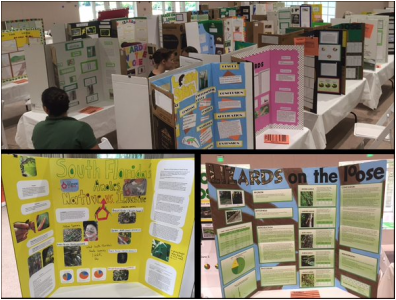
February 2016 - Here are some of the winning posters from our 2015-16 "Lizards on the Loose" Fairchild Challenge. Middle school students from 38 Miami area schools produced 65 research posters explaining the results of their lizard surveys. Click (here) for more information on the fantastic Fairchild Challenge science education program sponsored by Fairchild Tropical Botanic Garden.

January 2016 - Hanna, Oriol, and Jason were in Staniel Cay (Exumas, Bahamas) over winter break doing fieldwork with colleagues from Rob Pringle and Rowan Barrett's Labs. We caught hundreds of brown anoles from experimental islands for morphological and genetic studies. We also worked with Nate Dappen and Neil Losin from Day's Edge Productions to shoot video and interviews for their forthcoming Anolis lizard film series.
October 2015 - Jason and Peter Paton from the Department of Natural Resources Science at URI gave keynote addresses at the International Seminar on Biological Sciences hosted by the Universitas Sumatra Utara in Medan, Indonesia. Highlights included seeing Sumatran orangutans near Bukit Lawang and visiting Lake Toba, which occupies the caldera of a supervolcano that erupted ~70,000 years ago. Many thanks to our hosts It Jamilah, Alex Barus, and the wonderful students from USU.

Summer 2015 - Jason, Zac, Kevin, Andrew, and Oriol had a successful field campaign in Miami. Oriol and Zac's project on the effects of invasive predators and urbanization on variation in behavior and personalities of brown anoles is now out in Global Change Biology.

April 2015 - Kevin successfully defended his M.S. thesis. Congratulations! His research investigated how structural habitats altered by urbanization influence escape behavior of anoles and he conducted field research in San Juan, PR and Miami, FL. Good luck with your Ph.D. program at the University of Massachusetts Boston.

Spring 2015 - Congratulations to Ph.D. student Andrew Battles on winning a prestigious National Science Foundation Graduate Research Fellowship. Way to go Andrew! He is studying the ecological and evolutionary responses of anoles to urbanization. Andrew is seen here contemplating the urban landscape in Coral Gables, FL.

Summer 2014 - Check out these great anole videos and online labs featuring our research in the Bahamas produced by the Howard Hughes Medical Institute for their BioInteractive program. For the "Lizards in an Evolutionary Tree" video (click here). For the "Look Who's Coming to Dinner: Selection by Predation" video (click here). For the "Lizard Evolution Virtual Lab" (click here). Have fun!
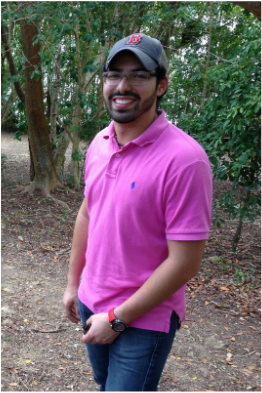
April 2014 - Jhoset successfully defended his M.S. thesis. Congratulations! His research focused on the effects of invasive Green Iguanas on seed germination and seed dispersal in a Puerto Rican mangrove forest. Now published in Biological Invasions. Jhoset is in law school continuing his pursuit of the gentleman-scholar ecomorph.
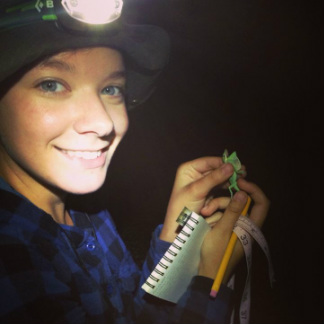
Summer 2013 - Haley's summer research focused on the short-term effects of artificial night lighting on behavior and performance of anoles, primarily in the Brown Anole (Anolis sagrei). Observations of normally diurnal anoles foraging under artificial lighting at night prompted previous researchers to describe a "night-light niche" for anoles. However, little research exists beyond isolated observations of lizards foraging under lights at night. Haley conducted a two-month experiment at the Montgomery Botanical Center in Coral Gables, Florida. During the first month, she collected pre-treatment data on anole habitat use and behavior during both the day and night. The second month began with the application of the night-light treatment (incandescent floodlights) and she continued to monitor habitat use and behavior as well as several measures of lizard performance. City lighting is dramatic example of human-mediated global change and we are only beginning to understand the consequences for some animals.

Summer 2013 - Jhoset spent the summer investigating the effects of invasive green iguanas (Iguana iguana) on mangrove plant communities and commercial plants at the Humacao Natural Reserve in northeast Puerto Rico. He collected and classified seeds from the reserve, and also collected scat from the field and from captive green iguanas feed Papaya (Carica papaya), which is an important crop at many Caribbean Islands. Approximately 1,200 seeds from both the Humacao Natural Reserve and captive green iguanas were planted and germinated under greenhouse conditions. Impacts of the green iguana invasion in Puerto Rico are debatable among scientists. Quantifying their effects on seed germination may reveal important interactions with local plant communities and help to clarify conservation and mitigation efforts of this species.
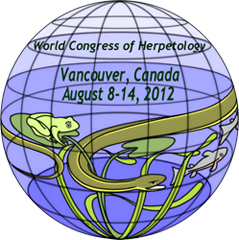
August 2012 - Jason and Tobias Uller (University of Oxford) organized a symposium at the 7th World Congress of Herpetology in Vancouver, Canada entitled "Insights from Invasions: Using Exotic Amphibians and Reptiles to Study Ecological and Evolutionary Processes." Featured talks included Rick Shine's (University of Sydney) work on invasive cane toads in Australia and Brad Shaffer's (UCLA) studies of hybridization between invasive and native tiger salamanders in California.

July 2012 - Check out our recent paper on the evolution of thermal tolerance during the introduction of Anolis cristatellus to Miami, FL. [PDF] Co-author Neil Losin's photo made the cover! See more great photos and videos from Neil and Nate Dappen at Day's Edge Productions.

June 2012 - Our lizard room at URI is operational and just in time for the arrival of over one hundred Anolis cristatellus from Miami and Puerto RIco. The first little guys hatched in late June and are doing well.

March 2012 - Our experiment with brown anoles in the Bahamas showing an interaction between founder effects and adaptive differentiation in determining phenotypic values received some nice media coverage. [PDF] [Washington Post] [NSF] [YouTube] [URI] [Anole Annals] [Live Science] [San Francisco Chronicle] ...and if you speak German!










